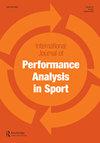精英短跑教练使用的训练方法
IF 1.6
4区 教育学
Q2 SPORT SCIENCES
International Journal of Performance Analysis in Sport
Pub Date : 2023-11-08
DOI:10.1080/24748668.2023.2277631
引用次数: 0
摘要
摘要关于优秀短跑运动员训练的科学知识有限,他们的训练在很大程度上依赖于经验丰富的教练的直觉和专业知识。因此,本研究的目的是为西班牙优秀短跑教练提供训练实践的概述。对14名自愿参与的短跑专业教练的定制问卷进行了描述性分析。这些教练使用传统(50%)和分段周期(50%)。许多教练(78.6%)将训练分为两个大周期中的三个阶段。此外,所有的教练都加入了不同持续时间的逐渐减少阶段。在一般准备阶段,重点是力量训练(78.6%)和速度训练(85.7%)。在特定制备阶段,强度-速度(92.9%)和速度-耐力(100%)优先。竞争阶段强调速度-强度(100%),加速度和最大速度(92.9%)。教练在冲刺训练前进行技术训练(100%),并进行具体的监测/测试(78.6%)。大多数教练还监测了疲劳指标(78.6%)和恢复参数(100%)。综上所述,西班牙优秀的短跑教练在整个赛季中都采用了相对相似的力量和短跑训练方法,逐渐将重点转向了比赛的特殊性。然而,这些教练实现了不同的宏观周期模型。关键词:运动员,运动周期,短跑成绩,力量和训练教练的实践。致谢第一作者获得了卡斯蒂利亚-拉曼查大学的资助(Ref. 2022-INVGO-11143)。披露声明作者未报告潜在的利益冲突。本文章由计算机程序翻译,如有差异,请以英文原文为准。
Training practices used by elite sprint coaches
ABSTRACTScientific knowledge of the training of elite athletic sprinters is limited, and much of their training relies on the intuition and expertise of experienced coaches. Therefore, the objective of this study is to provide an overview of the training practices employed by elite Spanish sprint coaches. A descriptive analysis was conducted using customised questionnaires from 14 sprint-specialised coaches who volunteered to participate. These coaches used both traditional (50%) and block periodisation (50%). Many coaches (78.6%) divided training into three phases within each of the two macrocycles. Additionally, all coaches incorporated a tapering phase of varying durations. During the general preparation phase, the focus was on strength training (78.6%) and tempo training (85.7%). In the specific preparation phase, priority was strength-speed (92.9%) and speed-endurance (100%). The competitive phase emphasised speed-strength (100%), acceleration and maximal velocity (92.9%). Coaches incorporated technique work prior to sprint sessions (100%) and conducted specific monitoring/testing sessions (78.6%). Most coaches also monitored indicators of fatigue (78.6%) and recovery parameters (100%). In conclusion, elite Spanish sprint coaches employ relatively similar strength and sprint training methods throughout the season, gradually shifting the focus towards competition specificity. However, these coaches implement different macro-periodisation models.KEYWORDS: Athleticsperiodisationsprint performancestrength and conditioningcoaches’ practices AcknowledgementsThe first author has been granted with funds provided by the Universidad de Castilla-La Mancha (Ref. 2022-INVGO-11143).Disclosure statementNo potential conflict of interest was reported by the author(s).
求助全文
通过发布文献求助,成功后即可免费获取论文全文。
去求助
来源期刊

International Journal of Performance Analysis in Sport
Health Professions-Physical Therapy, Sports Therapy and Rehabilitation
CiteScore
4.40
自引率
4.80%
发文量
38
期刊介绍:
The International Journal of Performance Analysis in Sport aims to present current original research into sports performance. In so doing, the journal contributes to our general knowledge of sports performance making findings available to a wide audience of academics and practitioners.
 求助内容:
求助内容: 应助结果提醒方式:
应助结果提醒方式:


